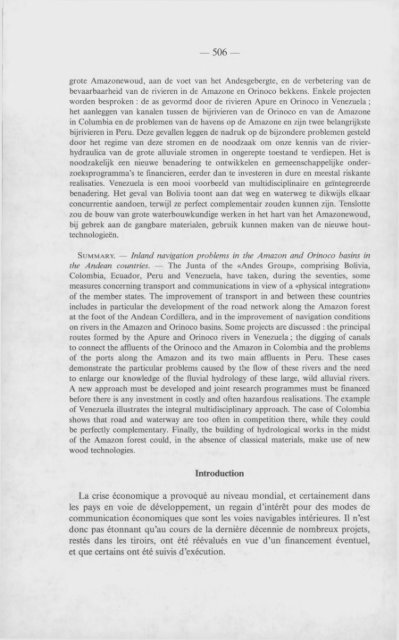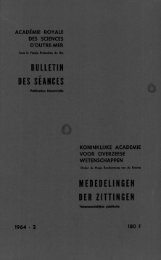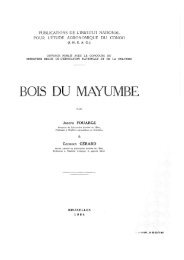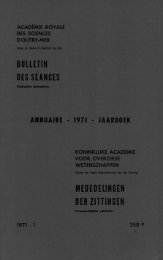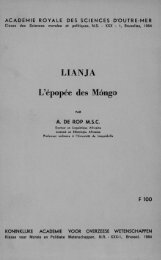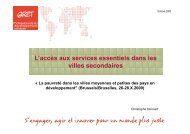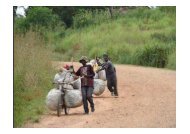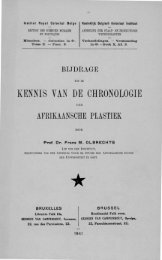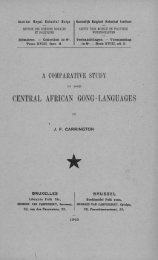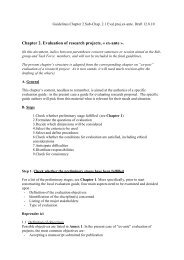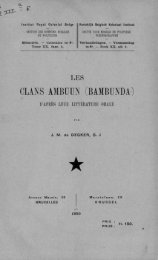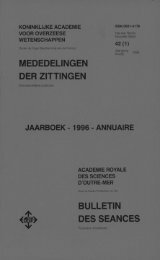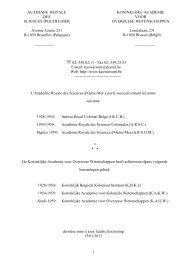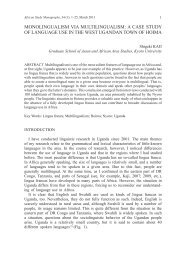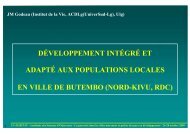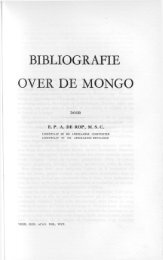(1992) n°3 - Royal Academy for Overseas Sciences
(1992) n°3 - Royal Academy for Overseas Sciences
(1992) n°3 - Royal Academy for Overseas Sciences
You also want an ePaper? Increase the reach of your titles
YUMPU automatically turns print PDFs into web optimized ePapers that Google loves.
— 506 —<br />
grote Amazonewoud, aan de voet van het Andesgebergte, en de verbetering van de<br />
bevaarbaarheid van de rivieren in de Amazone en Orinoco bekkens. Enkele projecten<br />
worden besproken : de as gevormd door de rivieren Apure en Orinoco in Venezuela ;<br />
het aanleggen van kanalen tussen de bijrivieren van de Orinoco en van de Amazone<br />
in Colum bia en de problemen van de havens op de Amazone en zijn twee belangrijkste<br />
bijrivieren in Peru. Deze gevallen leggen de nadruk op de bijzondere problemen gesteld<br />
door het regime van deze stromen en de noodzaak om onze kennis van de rivier-<br />
hydraulica van de grote alluviale stromen in ongerepte toestand te verdiepen. Het is<br />
noodzakelijk een nieuwe benadering te ontwikkelen en gemeenschappelijke onderzoeksprogram<br />
m a’s te financieren, eerder dan te investeren in dure en meestal riskante<br />
realisaties. Venezuela is een mooi voorbeeld van multidisciplinaire en geïntegreerde<br />
benadering. Het geval van Bolivia toont aan dat weg en waterweg te dikwijls elkaar<br />
concurrentie aandoen, terwijl ze perfect complementair zouden kunnen zijn. Tenslotte<br />
zou de bouw van grote waterbouwkundige werken in het hart van het Amazonewoud,<br />
bij gebrek aan de gangbare materialen, gebruik kunnen maken van de nieuwe houttechnologieën.<br />
S u m m a r y . — Inland navigation problem s in the A m azon and Orinoco basins in<br />
the Andean countries. — The Junta of the «Andes Group», comprising Bolivia,<br />
Colom bia, Ecuador, Peru and Venezuela, have taken, during the seventies, some<br />
measures concerning transport and communications in view of a «physical integration»<br />
of the member states. The improvement of transport in and between these countries<br />
includes in particular the development of the road network along the Amazon <strong>for</strong>est<br />
at the foot of the A ndean Cordillera, and in the improvement of navigation conditions<br />
on rivers in the Amazon and Orinoco basins. Some projects are discussed : the principal<br />
routes <strong>for</strong>med by the Apure and Orinoco rivers in Venezuela ; the digging of canals<br />
to connect the affluents of the Orinoco and the Amazon in Colom bia and the problems<br />
of the ports along the Amazon and its two main affluents in Peru. These cases<br />
dem onstrate the particular problems caused by the flow of these rivers and the need<br />
to enlarge our knowledge of the fluvial hydrology of these large, wild alluvial rivers.<br />
A new approach must be developed and joint research programmes must be financed<br />
be<strong>for</strong>e there is any investment in costly and often hazardous realisations. The example<br />
of Venezuela illustrates the integral multidisciplinary approach. The case of Colom bia<br />
shows that road and waterway are too often in competition there, while they could<br />
be perfectly complementary. Finally, the building of hydrological works in the midst<br />
of the Amazon <strong>for</strong>est could, in the absence of classical materials, make use of new<br />
wood technologies.<br />
Introduction<br />
La crise économique a provoqué au niveau mondial, et certainement dans<br />
les pays en voie de développement, un regain d ’intérêt pour des modes de<br />
communication économiques que sont les voies navigables intérieures. Il n’est<br />
donc pas étonnant qu’au cours de la dernière décennie de nombreux projets,<br />
restés dans les tiroirs, ont été réévalués en vue d ’un financement éventuel,<br />
et que certains ont été suivis d’exécution.


